Rudranath Trek: Most Difficult Trek Of Panch Kedar
- Key Points: Rudranath Trek, Gopeshwar, Sagar Village, Panch Kedar.
- State: Uttarakhand, India.
- Duration: 5 Nights 6 Days.
- Altitude: 3,559 meters (11,677 feet) above sea level.
- Trek Distance: Approximately 20 kilometers.
- Summer temperature: (15°C to 20°C)
- Winter temperature: (-5°C to5°C)
- Best Time To Visit: The ideal times for the Rudranath Trek are late spring (May to June) and early autumn (September to October) when the weather is mild, and the trails are accessible. The temple remains closed from November to April due to snowfall.
- Aarti Time: Morning Prayer starts at 8:00 AM and Evening Prayer starts at 6:30 PM daily.
- Trek Level: Moderate to Difficult.
- How to Reach: Take a bus from New Delhi to Rishikesh ISBT, then take a local bus/taxi from Rishikesh ISBT to Gopeshwar town, then take a local bus to Sagar Village, then from Sagar Village you can start your trek.
- Budget: ₹7,000-₹7,500 Per Person.
- Weather: In winter, Snow covers the peaks and in the summers you can experience a cool breeze.
Introduction to the Rudranath Trek
Nestled amidst the majestic Himalayan ranges, the Rudranath Trek stands as a testament to the captivating fusion of spirituality and natural beauty. This trek, less frequented than some of its counterparts, offers an opportunity for trekkers to not only experience the thrill of an adventure but also to immerse themselves in the serene aura of ancient temples and pristine landscapes. In this comprehensive guide, we will embark on a virtual journey through the Rudranath Trek, exploring its historical significance, scenic grandeur, challenges, and the profound sense of fulfillment it brings to those who tread its paths.
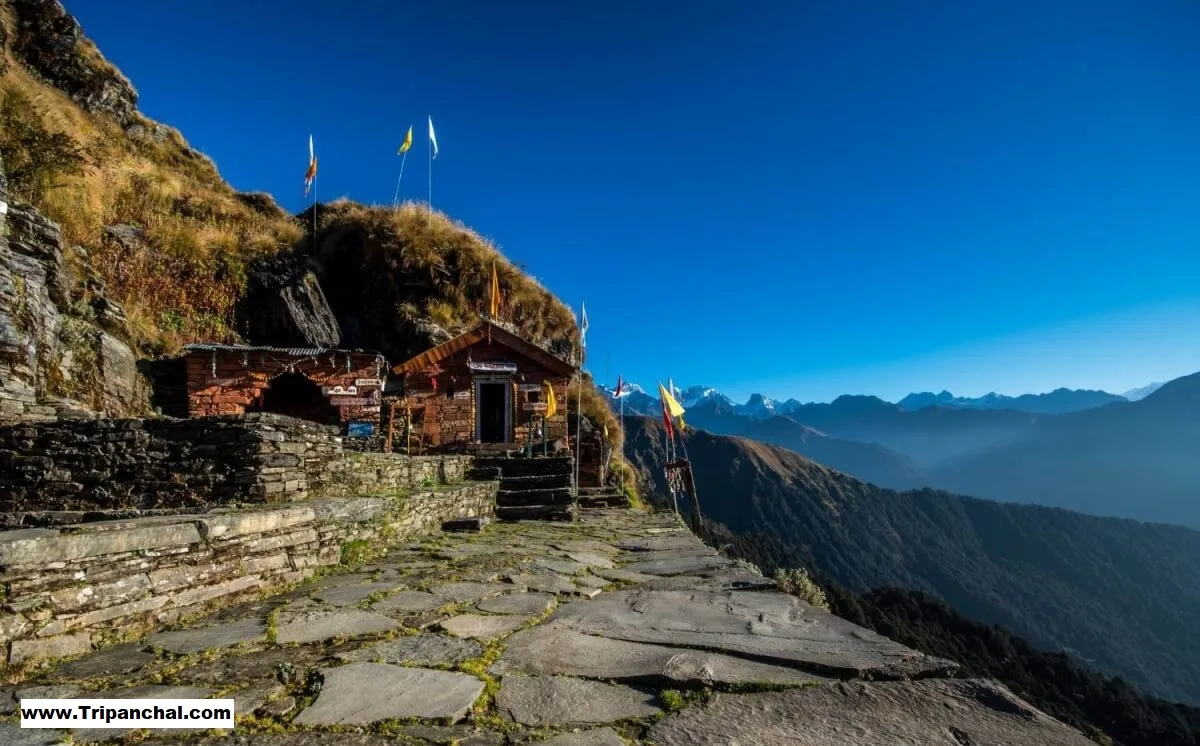
Table of Contents
1. The Mythical Charm of Rudranath Temple
1.1 Ancient Legends and Religious Significance
1.2 Architectural Marvel and Spiritual Atmosphere
2. Preparing for the Pilgrimage
2.1 Essential Trekking Gear and Equipment
2.2 Fitness and Health Preparations
3. The Trail Unleashed: Trek Itinerary
3.1 Gopeshwar to Sagar Village: Commencing the Expedition
3.2 Sagar Village to Panar Bugyal: Amidst Meadows and Melodies
3.3 Panar Bugyal to Rudranath Temple: Reaching the Divine Abode
3.4 Exploring Rudranath: Tranquility and Beauty Interwoven
4. Encounters with Nature: Flora and Fauna
4.1 Bountiful Flora of the Himalayan Ecosystem
4.2 Wildlife Wonders: A Glimpse of Fauna Diversity
5. Overcoming Challenges: Weather and Terrain
5.1 Navigating the Trail: Terrain Variations
5.2 Weather Woes and Best Trekking Seasons
6. Cultural Interludes: Villages and Locals
6.1 Village Hospitality and Cultural Exchanges
6.2 Preserving Traditions: Life in the Himalayan Villages
7. Finding Solitude: The Essence of the Trek
7.1 Disconnecting from the Modern World
7.2 Meditative Moments: Seeking Inner Peace
8. Capturing Memories: Photography and Reflections
8.1 Photography Tips for Preserving the Journey
8.2 A Trek of Self-Discovery: Reflecting on the Experience
1. The Mythical Charm of Rudranath Temple
1.1 Ancient Legends and Religious Significance
Legend has it that Lord Shiva, the supreme deity of the Hindu pantheon, took refuge in the Rudranath region to evade the Pandavas during their quest for redemption. This historical significance has rendered the temple a sacred destination for devotees and pilgrims.
1.2 Architectural Marvel and Spiritual Atmosphere
The Rudranath Temple, with its intricate architecture and serene ambiance, stands as a testament to the spiritual and artistic prowess of ancient craftsmen. The aura of devotion that envelops the temple premises is palpable, making it an ideal site for introspection and reverence.
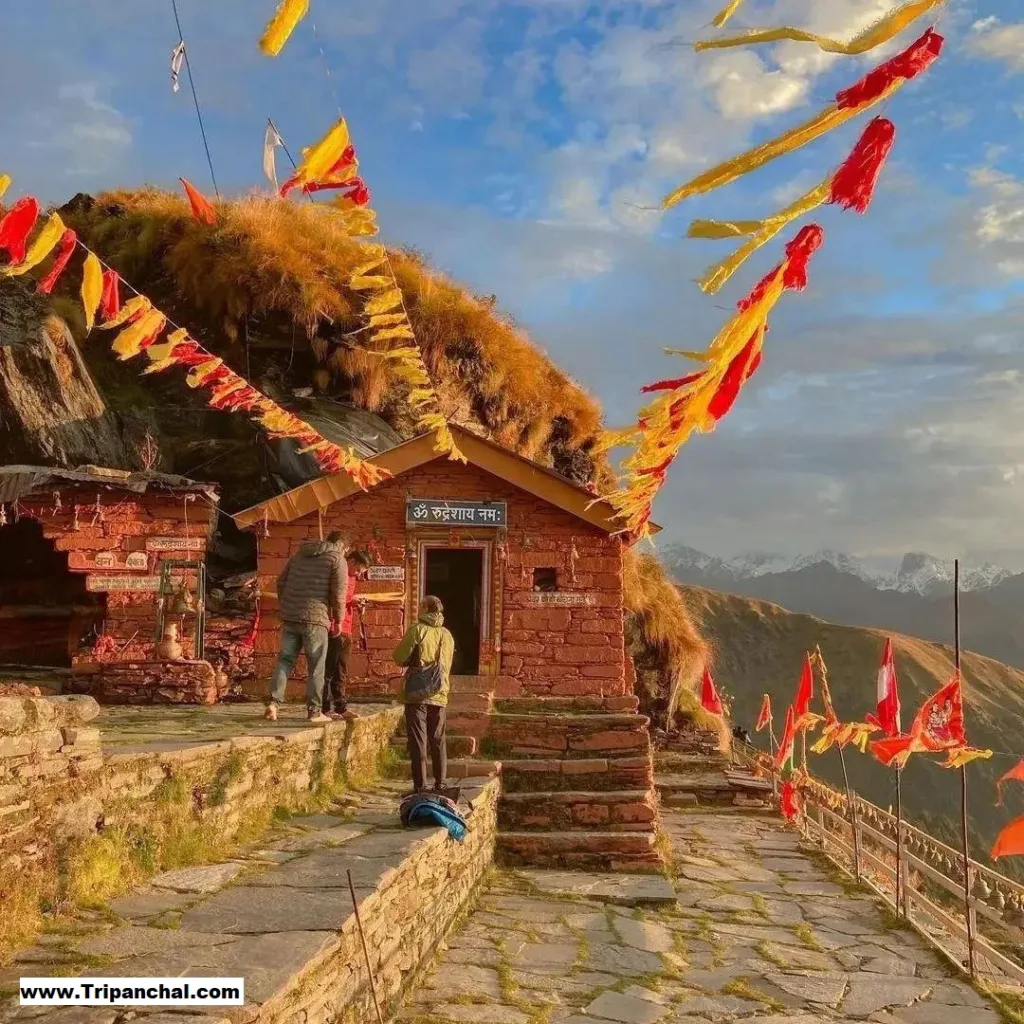
2. Preparing for the Pilgrimage
2.1 Essential Trekking Gear and Equipment
Before embarking on the Rudranath Trek, it’s essential to equip yourself with appropriate gear, including sturdy trekking shoes, comfortable clothing, a durable backpack, and essentials like water bottles, a first aid kit, and trekking poles.
2.2 Fitness and Health Preparations
The trek demands a moderate level of fitness. Engaging in regular cardio and strength exercises prior to the journey will help build stamina. Consultation with a medical professional is advisable to ensure you are physically prepared for the challenges ahead.
3. The Trail Unleashed: Trek Itinerary
3.1 Gopeshwar to Sagar Village (5 km)
The journey begins from Rishikesh, First you have to reach Gopeshwar town and from here, trekkers make their way to Sagar Village, the starting point of the trek, immersing themselves in the rustic beauty of the region.
3.2 Sagar Village to Panar Bugyal (12 km)
As trekkers ascend, the landscape transforms into a canvas of lush meadows known as bugyals. The Panar Bugyal, adorned with vibrant blooms and surrounded by towering peaks, offers a mesmerizing campsite.
3.3 Panar Bugyal to Rudranath Temple (8 km)
The trail to Rudranath Temple is an enchanting blend of dense forests, pristine streams, and panoramic views. The temple, hidden amidst nature’s embrace, emanates an aura of spirituality that captivates every pilgrim.
3.4 Exploring Rudranath: Tranquility and Beauty Interwoven
The temple’s tranquil atmosphere invites moments of introspection. As you explore the surroundings, you’ll be greeted by breathtaking vistas of snow-capped peaks and the serenity of the alpine environment.
Stay tuned for the next section of this article, where we’ll continue our journey through the enchanting Rudranath Trek, delving into encounters with nature, overcoming challenges, and embracing the cultural richness of the region.
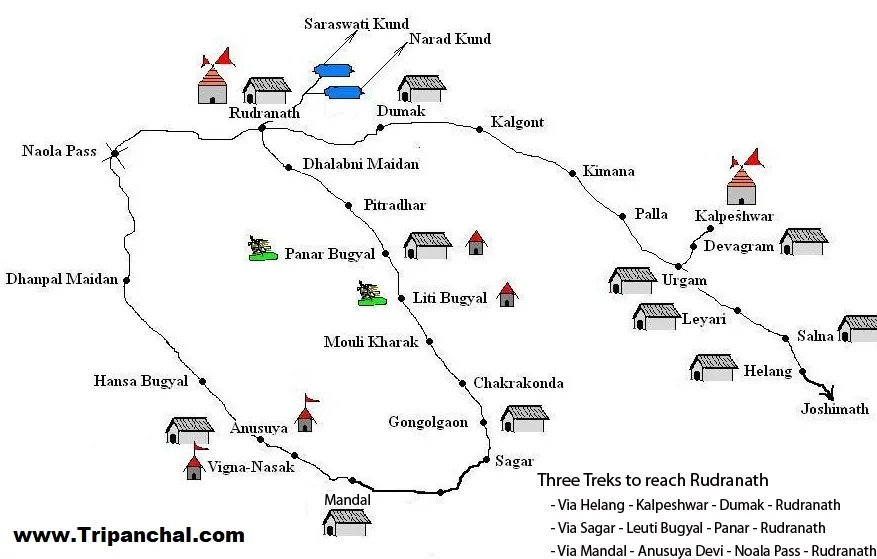
4. Encounters with Nature: Flora and Fauna
4.1 Bountiful Flora of the Himalayan Ecosystem
As you ascend through different altitudes, you’ll witness a remarkable transition in the vegetation. The lower reaches are adorned with rhododendron and oak forests, while the higher elevations reveal alpine meadows and fragrant juniper groves.
4.2 Wildlife Wonders: A Glimpse of Fauna Diversity
Keep your eyes peeled for a variety of wildlife that call this region home. You might spot the Himalayan monal, a colorful pheasant, along with musk deer, and even the elusive snow leopard if you’re lucky.
5. Overcoming Challenges: Weather and Terrain
5.1 Navigating the Trail: Terrain Variations
The trail encompasses a mix of terrains, from steep ascents to gradual descents. Proper trekking footwear and poles are your allies in tackling these variations with ease.
5.2 Weather Woes and Best Trekking Seasons
The weather in the Himalayas can be unpredictable. Summers and autumn are the best seasons for the trek when the skies are clear, and the temperatures are moderate. Winters bring heavy snowfall, making the trail inaccessible.

6. Cultural Interludes: Villages and Locals
6.1 Village Hospitality and Cultural Exchanges
The villages along the trek route are inhabited by warm-hearted locals who open their homes to trekkers. Interacting with them provides insights into their traditional way of life.
6.2 Preserving Traditions: Life in the Himalayan Villages
As you spend time in these villages, you’ll witness the preservation of age-old traditions. From handicrafts to cuisine, the culture of the region is rich and captivating.
7. Finding Solitude: The Essence of the Trek
7.1 Disconnecting from the Modern World
The absence of modern distractions allows you to reconnect with your inner self and truly appreciate the serenity of nature.
7.2 Meditative Moments: Seeking Inner Peace
The serene surroundings and tranquil ambiance offer moments of meditation and introspection, allowing you to gain a deeper understanding of yourself and the world around you.
Stay tuned for the concluding part of this article, where we will wrap up our journey through the Rudranath Trek, reflecting on the experience and its lasting impact.
8. Capturing Memories: Photography and Reflections
8.1 Photography Tips for Preserving the Journey
The Himalayan landscapes provide endless opportunities for breathtaking photographs. Capture the changing hues of the sky, the vibrant flora, and the panoramic vistas to relive the journey later.
8.2 A Trek of Self-Discovery: Reflecting on the Experience
As you descend from the heights of Rudranath, take a moment to reflect on the challenges conquered, the spiritual connections made, and the beauty of nature encountered.
A Spiritual Odyssey and Himalayan Marvel
The Rudranath Trek is more than a trek; it’s an odyssey that weaves together spirituality, adventure, and the splendor of nature. From the ancient legends that shroud the temple to the panoramic beauty of the Himalayas, this journey leaves an indelible mark on every pilgrim’s heart.
As you journey through varied terrains, encounter diverse flora and fauna, and immerse yourself in local cultures, you’ll find yourself transformed by the experience. The trek isn’t merely a physical one; it’s a journey of self-discovery, reflection, and connection with the natural world.
So, whether you’re seeking a spiritual escape, an offbeat adventure, or a chance to witness the magnificence of the Himalayas, the Rudranath Trek offers all this and more. Embark on this expedition, and you’ll return not just with memories and photographs, but with a deeper understanding of yourself and the world around you.
FAQs
Q1: Is the Rudranath Trek suitable for beginners?
The trek can be moderately challenging due to varying terrains. Prior trekking experience and good fitness levels are recommended.
Q2: What is the best time to undertake the Rudranath Trek?
The ideal time is during the summer months of May to June and the autumn months of September to October when the weather is pleasant and the trails are accessible.
Q3: Are there accommodation options available along the trek route?
Yes, there are basic guesthouses and homestays available in villages along the trail.
Q4: Are permits required for the trek?
Kedarnath forest area have come up with a new rule. If you’re planning to visit Rudranath, they will ask you to give them Rs 100 for each plastic thing you bring with you, like noodle packets, biscuit wrappers, or water bottles. This is to stop people from using so much plastic in the forest. When you come back after your visit, you need to show them the plastic wrappers to get your Rs 100 back. If you can’t show the wrappers, you might have to pay Rs 5000 as a punishment for making the hills dirty with plastic.
Q5: Is it possible to combine the Rudranath Trek with visits to nearby attractions?
Absolutely, trekkers often extend their journey to visit other Panch Kedar temples like Tungnath and Kalpeshwar for a holistic experience.
Q6: How much is the Rudranath trek distance?
Approximately 20 kilometers from each side.
Q7: How to save the Rudranath Trek Map?
There are three trekking routes to reach the Rudranath temple:
(i) 1st Route: Helang-Urgam-kalpeshwar-Dumak-Bansi Narayan-Panar-Rudranath
(ii) 2nd Route: Sagar Village-Liti Bugyal-Panar Bugyal-Pitradhar-Rudranath
(iii) 3rd Route: Mandal Village- Anasuya Temple-Hansa Bugyal- Naola Pass- Rudranath
* By right click on the above mentioned map, select “save image as” option and download it.
Q8: Kedarnath opening date 2024?
Kedarnath opening ceremony will be held on 10th May 2024.
Q9: Rudranath opening date 2024?
Rudranath opening ceremony will be held on 18th May 2024.
Q10: Panch kedar opening date 2024?
Kedarnath- 10th May 2024.
Madhyamaheshwar- 20th May 2024.
Tungnath- 10th May 2024.
Rudranath- 18th May 2024.
Kalpeshwar- Open all year round.
Things to keep in mind while traveling:
- Do not roam alone at night. It’s not safe.
- Respect Pahari culture and Don’t argue/fight with people around you.
- Do not litter in the mountains.
- Save mountains, Save Nature.
- Don’t do trekking with drugs.
- Always carry a medical box, torchlight, trekking stick, trekking shoes, warm clothes, and a water bottle with you.
- Always walk carefully, Do not trek in bad weather.
By clicking on the below link, you can book a room in the homestay/Camping according to your choice
Krishna Homestay, Sagar Village
Maharaja Sagar Global Residential Homestay
Cafe’s Nearby Gopeshwar Town
Also Read: How to reach kartik swami temple from Delhi
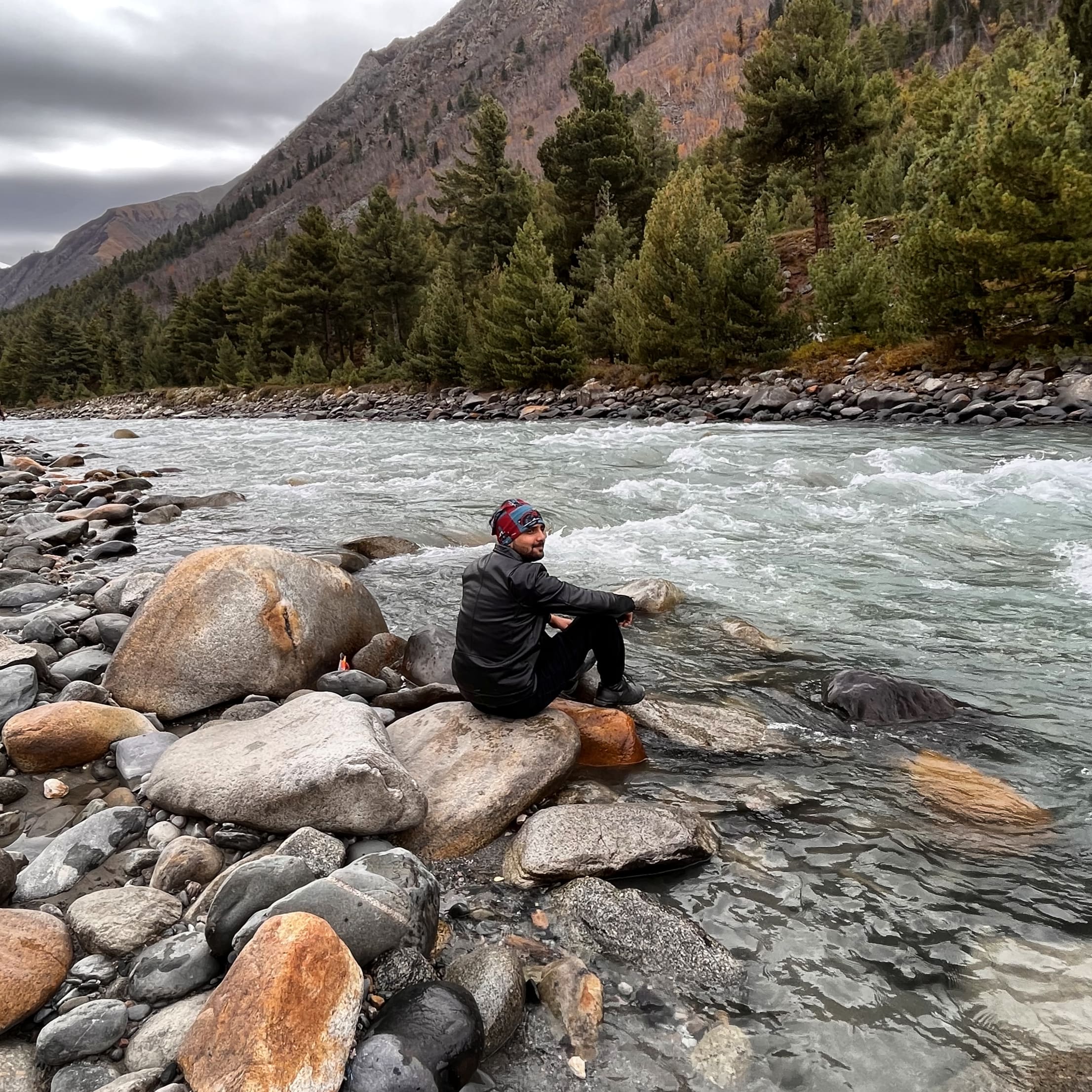
Let me introduce myself quickly. I’m the Author of Tripanchal, I have completed a Bachelor of Technology from YMCAUST and am a Senior Engineer in a Japanese MNC.
So, here I publish articles based on my travel experiences and insights through my writing and photography, inspiring others to explore nature and embrace new cultures.
If you want to get information about travel then you are on the right website.
I hope you are enjoying our articles as much as we enjoy offering them to you.
If you have any questions or comments, Please give feedback to us at tripanchal01@gmail.com
Best Regards
Abhishek Saini
Author

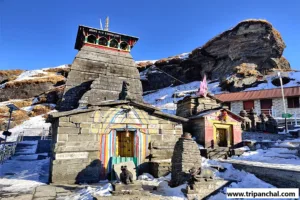
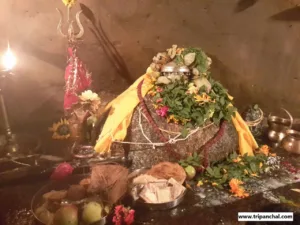

I’m not that much of a online reader to be honest but your sites really nice, keep it
up! I’ll go ahead and bookmark your site to come back later on. Many thanks
Thank you
Hello! I wanted to drop by and say that I really enjoyed this blog post. Your writing is always so clear and concise, and you have a talent for making complex topics easy to understand. Thank you for sharing your insights with us. I’m looking forward to your next post!
Thank You 🙂
Greetings! I just wanted to let you know how much I appreciated this blog post. Your writing is always so engaging and informative. It’s clear that you have a deep understanding of the subject matter. Thank you for sharing your expertise with us. Looking forward to your next post!
Thank You 🙂
temple will be closed in november ,,but can i still trek in november , is it open to trek during november /december ?
keep note before starting the Rudranath Trek in November/December:
1. Most of the time trek get closed due to heavy snowfall in November/December month. Means trail is not accessible due to snow.
2. There are chances, you will get stop by forest guards. So, its better to plan your trip in summers.
3. If you really want to this trek in winters, it is totally up to you. There are chances of getting encountered with wild animals. So, please plan accordingly.